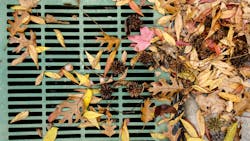Across the country, the increasing intensity of storm events has put pressure on stormwater utilities to find solutions to these issues. As these events become more common, the risk of urban flooding increases. In the Midwestern U.S., like most of the country, cities are faced with not only a stormwater quantity problem that comes with intense rainfall, but stormwater quality issues as well.
“At the same time that large rain events seem to be increasing, states are adding to their impaired waters list and developing total maximum daily load (TMDL) studies to try to understand what they need to do to move toward the Clean Water Act goal of ‘fishable and swimmable’ and restore the chemical, physical, and biological quality characteristics of those waters,” says Chuck Boehm, client services director with Brown and Caldwell. “And that means the states are having to put limits on the amount of stormwater runoff and pollutants that are discharged so they can improve the health of those waterways.”
Boehm is a professional engineer licensed in Wisconsin and two other states in the U.S. He’s been working in the stormwater industry for 30 years, assisting municipal clients on tackling their stormwater issues, from designing and planning projects to developing guidance for stormwater utilities.
Municipalities are now facing the prospect of managing more and larger rainfall runoff events and flooding — along with increased stormwater quality management expectations at the same time. When dealing with stormwater quantity and flooding, while there has long been a focus on the use of computer modeling in stormwater management studies, Boehm says he sees municipalities using a more “thought-out approach to developing stormwater management plans and watershed studies so that they are being conducted with a consistent methodology to all areas.”
Applying a consistent methodology allows utility managers to compare data from one area to another more directly and to better prioritize solutions, making the best use of available resources to be prepared for future events.
“We’re also seeing a lot more 2D modeling, working with models that provide results that are more visually striking,” Boehm says. “So, it’s not just a lot of data, you actually have the graphics that go with it, and you can more readily visually see what’s happening on the ground when a rain event happens.”
As to how to approach the trend of increasing and larger rain events, municipalities are modifying their local stormwater ordinances to evaluate and manage larger events. Groups like the Wisconsin Initiative on Climate Change Impacts (WICCI) are studying climate trends and developing tools to help municipalities adapt to these trends.
On the stormwater quality side of the coin, Boehm notes, as the EPA and state agencies look to add new water quality regulations for pollutants such as PFAS and chloride, stormwater utilities will need to adjust to meet these changing regulations. The use of salt and other deicing agents in the Midwest is something that will need additional focus.
“As new research is conducted and guidance documents from states and agencies are developed help to address TMDL requirements for emerging contaminants, traditional pollutant mitigation methods may need to be revaluated,” he says. “[Looking at] phosphorus in particular, which has such a large dissolved fraction in the runoff — traditional practices like wet detention just can’t do it all.”
In the Midwest, much of the phosphorus load entering storm drains comes from fallen leaves, which land in the street, get run over by cars, and create “a tea-like byproduct that leaches into waterways.” The U.S. Geological Service is working with the Wisconsin Department of Natural Resources and municipalities to study urban runoff, finding ways to keep phosphorus out of the water and address the problem at its source by collecting leaves before the “tea” is made.
Other researchers, such as the University of Minnesota’s St. Anthony Falls Laboratory, are currently studying ways to remove phosphorus by using additives such as slag or iron filings, which chemically attach to the phosphorus to enhance traditional practices and remove phosphorus once it gets into stormwater runoff.
“There’s a lot of really good science out there that’s helping us find ways to address [stormwater pollution] either by proactively removing it from contact by using source controls, or to address it on the back end with treatment technologies,” Boehm says. “Unfortunately, the bottom line is, whatever you do, we’re finding it to be an expensive course of action, and quantity and quality needs are always competing for dollars.”
When cities can develop multipurpose facilities that address both water quality and quantity management, the result is a win-win scenario.
“[You’ll] get that visual flooding reduction which draws lot of support from governmental stakeholders as well as your general citizens who [may only see] the flooding, and don’t always see the quality [issues],” Boehm says. “At the end of the day, it just comes down to competing resources and finding the best way to address the two problems.” SW
Published in Stormwater magazine, May 2022.






